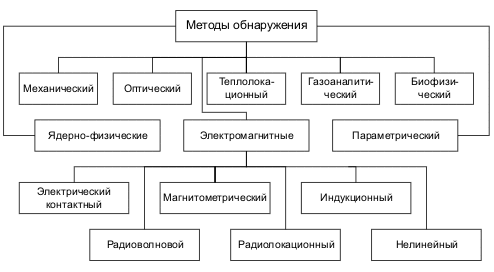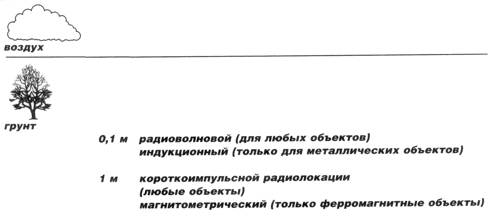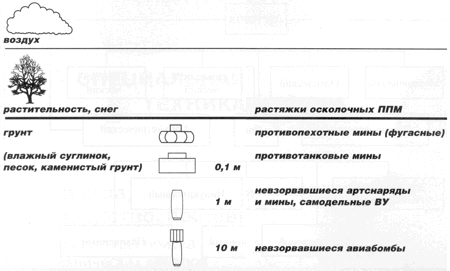Continuation of the article: Methods of mine detection — in relation to the problem of humanitarian demining
Detection methods
Mines and explosive devices are usually located in sheltering environments.
Shelting environments can be:
— soils of various composition and humidity (the most typical case);
— fresh water from rivers and lakes;
— sea water;
— vegetation:
— snow, ice;
— building materials (bricks, concrete, etc.).
In relation to the issue under consideration, their main material characteristics are: density, hardness, electrical conductivity, permittivity and magnetic permeability, reflection and radiation coefficients in the visible (0.4…0.76 μm) and infrared (0.76…1000 μm) ranges of electromagnetic waves, etc.
The following search objects and their depths in the concealing environment are typical for humanitarian demining:
Fig. 1. Characteristic search objects
It is generally accepted that mine detection is carried out in two directions:
— search for individual mines (characteristic distances here are from several centimeters to several meters);
— reconnaissance of minefields (characteristic distances are from tens of meters to several kilometers).
Ideally, it is desirable to detect an individual mine at a safe distance (at least 70…100 meters from the sapper). It is desirable to conduct reconnaissance of minefields at any time of day and in any weather conditions from the air with carrier speeds from tens to hundreds of km/h.
Moreover, when detecting a mine, the main problem is recognizing the useful signal (from the mine) against the background of numerous interferences from environmental inhomogeneities and various inclusions.
For example, at present, when searching for mines on the ground using the portable mine detector IMP-2, for several dozen interferences from foreign metal objects there is only one useful signal (from a mine or improvised explosive device).
Table 1 shows the most important unmasking features of mines and explosive devices, implemented during the search.
Table 1. Unmasking features of mines and explosive devices
| Name of the contrast between the object and the containing environment | Search object type | |||
| PPM | PTM | Mines and explosive devices with electronic components | VU mines with wire control line | |
| Difference in electrical conductivity | + (may be very small) |
+ | + | + |
| Difference in magnetic permeability | ± | ± | + | + |
| Difference in permittivity | + | + | + | + |
| Differences in thermophysical characteristics | ± | ± | ± | ± |
| Differences in optical characteristics | ± | ± | ± | ± |
| Difference in mechanical characteristics | + | + | + | + |
| Presence of explosive vapors | ± | ± | ± | ± |
| Presence of nonlinear electromagnetic properties | ± | ± | + | ± |
+ – contrast is present;
± – contrast is not always present
Detection methods implementing these features are given in Fig. 2.
The current state of possible methods for detecting objects of artificial origin is characterized by diversity.
Their analysis shows that each of them has certain limitations.
Of course, it is necessary to take into account both a priori information about the search object (size, materials, etc.) and the properties of the covering environment.

Fig. 2. Basic methods of searching for mines in concealing environments
Currently, the following methods are most widely used in domestic developments: electromagnetic (induction, radio wave, magnetometric, nonlinear), nuclear-physical, thermal and mechanical (mechanical probing).
They are the ones that make it possible to create field technical means of mines and explosive devices suitable for humanitarian demining.
The main issues here are safety issues and reducing the costs of mine clearance.
Other requirements: climatic, efficiency of work in the dark, resistance to impact, electromagnetic compatibility, etc. — are less stringent than for military mine detectors.
Fig. 3. characterizes the real “depth” of the most practically significant contactless search methods (in relation to the problem under consideration).

Fig. 3. “Depth” of the main search methods
for detecting mines and unexploded ordnance
To increase the efficiency of mine detection, it is advisable to combine various search methods in one technical means.
One of the new promising methods of mine detection is parametric. It is based on recording the interaction of exciting (force) and probing (information) physical fields on artificial search objects (mines). The combination of these fields can be different.
CONCLUSIONS
1. The problem of rendering harmless already installed antipersonnel mines and antitank mines is of a global nature. The economic development of a number of regions of the Earth, including Europe, depends to a certain extent on its successful solution.
2. The main unresolved issue in the mine clearance problem is the low efficiency of detecting small-sized antitank mines, primarily non-metallic high-explosive mines.
3. It is also necessary to increase the reliable detection range of fragmentation antitank mines with tripwires.
4. To solve the problem, it is advisable to create new means of mine detection that combine several independent detection channels with a single signal processing unit.
5. In Russia there are certain development prospects, carried out taking into account practical experience. They can be used in solving the problem of humanitarian demining.
